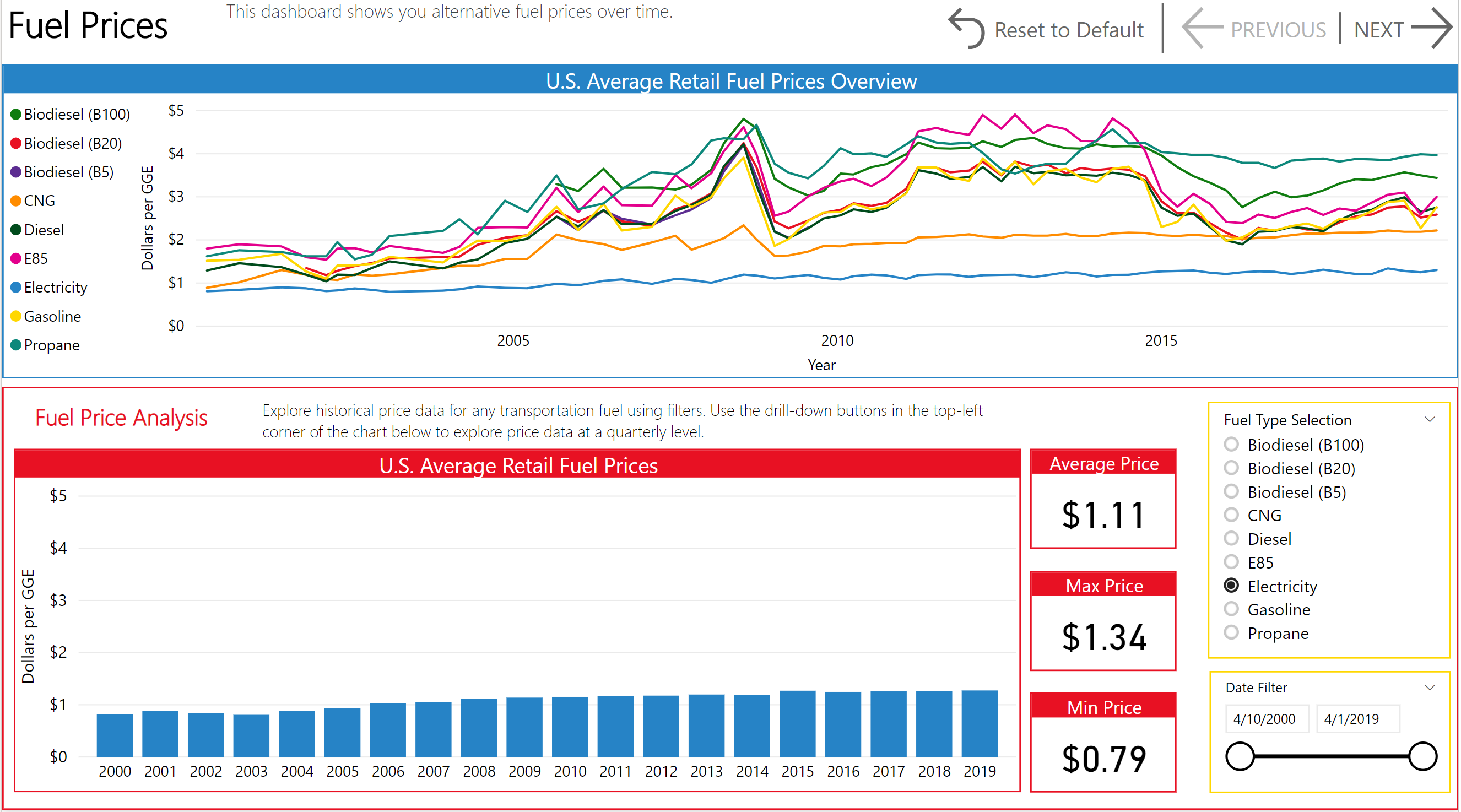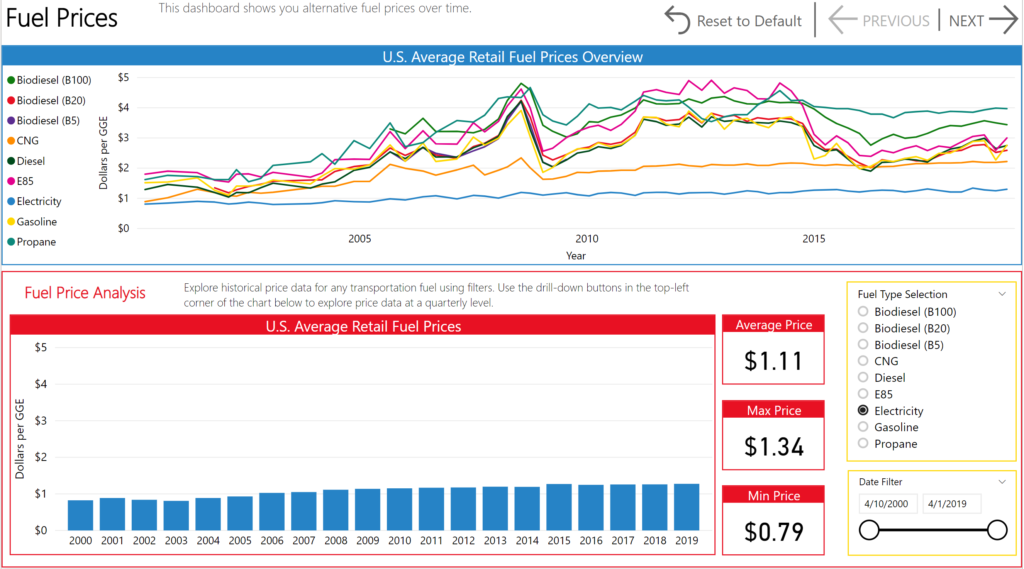Alternative fuels are transportation fuels derived from sources other than oil. Fuels can be produced from a variety of feedstocks such as food waste, natural gas, and renewable energy. Most fuels can be used in any vehicle class (light-, medium-, and heavy-duty), but the availability of alternative fuel vehicles (AFVs) and their suitability for different applications varies. This page provides a brief overview of the most common alternative fuels, AFV types, and frequently asked questions on state fleet uses and policy issues.
Alternative Fuel Options
Biodiesel: A renewable, biodegradable fuel manufactured from vegetable oils, animal fats, or recycled restaurant grease, biodiesel is a liquid fuel referred to as B100 or neat biodiesel in its pure, unblended form and B5 and B20 when blended with conventional diesel at 5% or 20% blends, by volume, respectively. Like petroleum diesel, biodiesel is used to fuel compression-ignition engines, which run on petroleum diesel. Biodiesel causes far less damage than petroleum diesel if spilled or released to the environment. It is also safer than petroleum diesel because it is less combustible. The flashpoint for biodiesel is higher than 130°C, compared with about 52°C for petroleum diesel. Biodiesel is safe to handle, store, and transport.
CNG: Compressed Natural Gas (CNG) is produced by compressing natural gas to less than 1% of its volume at standard atmospheric pressure. To provide adequate driving range, CNG is stored onboard a vehicle in a compressed gaseous state within cylinders at a pressure of 3,000 to 3,600 pounds per square inch. CNG is used in light-, medium-, and heavy-duty applications. A CNG-powered vehicle gets about the same fuel economy as a conventional gasoline vehicle on a gasoline gallon equivalent (GGE) basis. A GGE equals about 5.66 pounds of CNG.
Electricity: Plug-in electric vehicles (EVs) have onboard rechargeable batteries store energy to power electric motors. All Electric Vehicles (AEVs) are powered solely by the battery while Plug-in Hybrid Vehicles (PHEVs) can be powered by the battery or an internal combustion engines. Vehicles running on electricity produce no tailpipe emissions, but there are upstream emissions created in the electric generation process which vary depending on the source.
Ethanol: Ethanol is available as E85, a blend containing 51%-83% ethanol depending on season and geography for use in Flexible Fuel vehicles. E15 is defined by the Environmental Protection Agency as a blend of 10%-15% ethanol with gasoline. It is an approved ethanol blend for model year vehicles 2001 and newer.
Hydrogen (gaseous): Hydrogen is a compressed gaseous fuel typically used in a fuel cell to power an electric motor. The fuel can also be combusted in an internal combustion engine. The interest in hydrogen as an alternative transportation fuel stems from its ability to power fuel cells in zero-emission electric vehicles, its potential for domestic production, its fast filling time, and the fuel cell’s high efficiency.
LNG: Liquefied natural gas (LNG) is produced by purifying natural gas and super-cooling it to -260°F to turn it into a liquid. During the process known as liquefaction, natural gas is cooled below its boiling point. The remaining natural gas is primarily methane with small amounts of other hydrocarbons. Because of LNG’s relatively high production cost as well as the need to store it in expensive cryogenic tanks, the fuel’s widespread use in commercial applications has been limited. LNG must be kept at cold temperatures and is stored in double-walled, vacuum-insulated pressure vessels. LNG is suitable for trucks that require longer ranges because liquid is more dense than gas (CNG) and, therefore, more energy can be stored in the same tank volume. LNG is typically used in medium- and heavy-duty vehicles. A GGE equals about 1.5 gallons of LNG.
Propane: Also known as liquefied petroleum gas (LPG) or propane autogas, propane has a high octane rating, making it a suitable choice for spark-ignited internal combustion engines. It presents no threat to soil, surface water, or groundwater. Propane is produced as a by-product of natural gas processing and crude oil refining. Propane is stored onboard a vehicle in a tank pressurized to about 150 pounds per square inch about twice the pressure of an inflated truck tire. Propane has a higher octane rating than gasoline, which prevents engine knock. However, it has a lower Btu rating than gasoline, so it takes more fuel to drive the same distance.
Renewable Diesel: Broad class of fuels derived from biomass feedstocks, including soybeans, animal fats, and waste oils and processed through hydrotreating or Fischer-Tropsch synthesis. This fuel meets petroleum diesel specifications and can be used in unmodified petroleum diesel engines or fueling infrastructure.
Vehicle Availability
| Vehicle Class | Vehicle Type | Biodiesel (B100) or E85 | CNG | Electricity | Hydrogen (Gaseous) | LNG | Propane | Renewable Diesel | RNG |
| Light-Duty | Passenger Cars | ||||||||
| Light Trucks | |||||||||
| Medium- & Heavy-Duty | Beverage, Dump, Tow, Utility, Refrigerated Van | ||||||||
| Box Van, School Bus, Step Van | |||||||||
| Concrete Mixer, Trash | |||||||||
| Tractor Trailer | |||||||||
| Transit Bus |
Green = widely available. Orange = limited availability/demonstrations only. Red = no availability.
The US Department of Energy’s Alternative Fuels Data Center (AFDC) has a wealth of resources on different AFV options, including a publication listing 2018 model year AFVs.
Fuel Locations, Fuel Prices, and CO2 Emissions Estimates
The AFDC has an alternative fuel station locator with verified locations of biodiesel, CNG, electric, ethanol, hydrogen, LNG and propane which is updated regularly as new stations come online.
The AFDC has also developed smartphone apps to access the fueling locations which are available for download as an iPhone app or Android app.
Explore a dashboard fuel prices and carbon dioxide for various alternative fuel and conventional vehicles.
Frequently Asked Questions
AFVs are still a small proportion of the overall fleet in most states, so the issue has not had major impacts on transportation funding yet. Several states have enacted added fees for AFV registrations and/or volumetric taxes for AFV fuels similar to gasoline taxes. The National Conference of State Legislators has resources tracking state incentives and fees for AFVs.
Consult your state’s “designated beneficiary” for information on VW spending priorities for medium and heavy duty AFVs and AFV fueling infrastructure. In most states this will be the environmental agency. Additional VW settlement resources are available at the National Association of State Energy Officials , the National Association of Clean Air Agencies , and the Atlas EV Hub.
Local Clean Cities Coalitions offer many resources for AFV fleets and are often the best place to begin.
A number of other internet and conference resources are available for those looking to go deeper, including:
- Fleets for the Future website
- EV Smart Fleets website
- West Coast Electric Fleets website
- Advanced Clean Transportation (ACT) Expo
Check our AFV fuel price dashboard above or our AFV cost calculator to better understand the total cost of ownership of AFV options.
Federal and state tax credit programs are available to reduce the purchase cost of AFVs, so tax exempt public agencies may want to explore leasing options with private companies to access these incentives. The EV Smart Fleets project includes a case study of capturing the federal tax credit for electric vehicles .
We recommend starting with our AFV action guide for state and regional transportation agencies.
The development of the AFV toolkit included several workshops with State DOTs. A series of fact sheets are available with more information on DOT fleet use of AFVs.
For More Information on Alternative Fuels
- Alternative Fuels Data Center: Comprehensive resource on alternative fuels, including fueling station locations, fuel prices, research publications, and more. Created and managed by the U.S. Department of Energy.
- Greenhouse Gases, Regulated Emissions, and Energy Use in Transportation (GREET) Model: Full lifecycle assessment of greenhouse gas emissions from a variety of vehicles and fuels. Developed by Argonne National Laboratory.
- Low-Carbon Fuel Standard Emissions: Table of the fuel pathways used in California’s Low-Carbon Fuel Standard. Developed for the California Air Resources Board.
- Transportation Energy Data Book: A valuable resource containing data on transportation with an emphasis on energy. Created and managed by the Oak Ridge National Laboratory.


